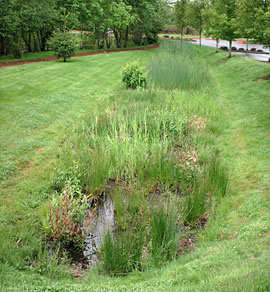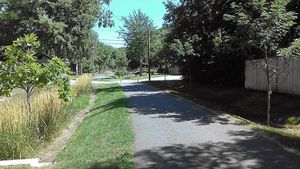
Overview for pretreatment vegetated filter strips
It is important to tailor a pretreatment practice to the specific site and type of receiving structural stormwater best management practice (BMP). Many factors influence the choice of pretreatment practices, including but not limited to: (1) contributing area characteristics ( contributing drainage area, connected imperviousness, land uses, soils, slopes, dominant vegetation, source controls in place, and availability of public lands ); (2) existing infrastructure (above and below ground); and (3) type of structural stormwater BMP with infiltration/ filtration BMPs having that have the greatest need for removal of solids prior to treatment areas. The following section describes the specific strengths, weaknesses, and applicability of pretreatment vegetated filter strips.
Contents
Processes
Pretreatment vegetated filter strips are designed to provide sedimentation and screening (by vegetation) to treat stormwater runoff prior to entering a structural stormwater BMP. Pretreatment vegetated filter strips are especially effective at capturing excess sediment in stormwater runoff by settling solids. Pretreatment vegetated filter strips provide limited (due to size) volume reduction, peak flow reduction, infiltration, and biological treatment. Stormwater management processes not provided in pretreatment vegetated filter strips include filtration and sorption.
Applicability and suitability
Pretreatment practices are NOT stand-alone treatment practices and should only be installed in conjunction with a treatment practice immediately downstream. The applicability of pretreatment vegetated filter strips with regard to the cold climate, retrofits, highly urban and ultra-urban environments and other considerations is presented below.
Cold Climate Suitability
During winter months, pretreatment vegetated filter strips will become frozen and covered by ice and snow to some extent. This will diminish the effectiveness of the practice if flows become channelized, resulting in reduced trapping of sediments. Once the snow and ice melts, sheet flow is re-established, and vegetation actively removes sediment, pretreatment filter strips will provide some snowmelt treatment. Pretreatment vegetated filter strips are often less effective during cold climate conditions due to reduced biological activity (dormant vegetation) and reduced settling velocities. Storing snow on pretreatment vegetated filter strips is not recommended because it will extend the duration of ineffective treatment due to increased snowpack. In rare instances, some types of invasive annual vegetation reduce perennial cover which results in periods of unestablished vegetation during periods of runoff (e.g., winter thaws and spring snowmelt events) and less pretreatment.
Retrofit Suitability
Pretreatment vegetated filter strips tend to require more space than other pretreatment practices, which often limits retrofit suitability.
Ultra-Urban Suitability
Pretreatment vegetated filter strips tend to require more space than other pretreatment practices, and thus they are often not suitable in ultra-urban settings where space is limited.
Other Considerations
Channelized inflows to the pretreatment vegetated filter strips must be avoided because concentrated flows will reduce the effectiveness of the practice. For some sites, footprint area is a constraint because pretreatment vegetated filter strips often require more surface area than other pretreatment practices. Pretreatment vegetated filter strips are not designed to infiltrate water, but treatment filter strips are suitable as part of a structural stormwater BMP
Applicability to MPCA stormwater permits
If designed properly, this practice meets the intent of the Construction stormwater permit, as pretreatment for an infiltration or filtration system.
Advantages and limitations
The advantages and limitations of pretreatment vegetated filter strips with regard to the pollutant removal capabilities, cost, ease of construction and maintenance, space and other design considerations and compatibility are discussed below.
Advantages
Pretreatment vegetated filter strips provide many advantages as a pretreatment practice. They effectively remove sediments from stormwater runoff. The construction of this practice is often relatively simple compared to other pretreatment practices, though it does require a level spreader along with establishment of vegetative cover including periodic vegetation maintenance. Pretreatment vegetated filter strips are often easily accessible which makes maintenance more manageable and often have less non-routine maintenance costs (e.g. do not require the use of heavy equipment). Pretreatment vegetated filter strips offer aesthetic aspects enhancing stormwater designs desired in Green infrastructure settings.
Limitations
Pretreatment vegetated filter strips require runoff to be conveyed in shallow, distributed sheet flow. To maintain their effectiveness, pretreatment vegetated filter strips require regular routine inspection and maintenance to remove accumulated sediment and debris. Sediment and debris that is not removed often results in bypass flow or channelization of erosive flows through the pretreatment vegetated filter strip. Sites requiring re-sloping/grading and imported specification soils often incur additional construction costs due to the use of heavy equipment and associated labor. High loadings of pollutants might damage the vegetation (e.g., vegetation adjacent to a roadway or parking lot with high application rates of deicers). Proper siting and design will improve long-term performance and reduce maintenance expenses. Although pretreatment vegetated filter strips are suitable for many receiving structural stormwater BMPs, space and site requirements (e.g., slope, flow distribution) are the most common limits for the applicability of this practice.
Water quantity treatment
Pretreatment vegetated filter strips are designed to ease maintenance and prolong the lifespan of the downstream structural stormwater BMP, and thus provide limited volume reduction (due to size). Pretreatment vegetated filter strips are not to be confused with the structural stormwater BMP treatment vegetated filter strips, which are designed and used as a stand-alone structural stormwater BMP to reduce stormwater runoff volumes.
Water quality treatment

Properly designed pretreatment vegetated filter strips slow runoff velocities and allow sediment to settle. Pretreatment vegetated filter strips can also remove portions of other pollutants in runoff, including small particulates, hydrocarbons, heavy metals and nutrients such as phosphorus and nitrogen. Filter strips remove pollutant load through sedimentation, filtration, infiltration, biological uptake, and microbial activity.
The water quality benefit of a vegetated filter strip is dependent upon factors such as the length of the flow path and slope, stormwater flow rate through the vegetated filter strip, the type, density, and length of vegetation, the ability to maintain sheet flow through the vegetated filter strip and the soil properties that influence infiltration rate. The ability to maintain sheet flow is often cited as a crucial factor for the success of filter strips (Lake Superior Streams; Virginia DEQ, 1999)
In general, pretreatment vegetated filter strips are very effective at removing solids from stormwater if there is adequate flow path length and if sheet flow is maintained through the BMP with low rate of flow (Goel et al., 2004; Abu-Zreig et al., 2003; Gharabaghi et al., 2000; see References for pretreatment).
Performance of pretreatment vegetated filter strips
The following discussion provides a summary of information found in the literature. The information provides a general summary and indication of the range of pollutant removal and should not be used for design purposes.
Solids removal can vary between 50 and 98 percent depending on filter strip characteristics (NJ DEP, 2014; Goel et al., 2004; Abu-Zreig et al., 2003; Gharabaghi et al., 2000). Gharabaghi et al., 2000 found that 50 percent of sediments settled in the first 2.5 meters of a vegetated filter strip and an additional 25 to 45 percent of sediments settled in the next 2.5 meters. They also concluded that increased solids removal was minimal in flow path lengths greater than 10 meters. Some stormwater manuals require a minimum filter strip length of 10 feet with a slope of less than 2 percent (Inver Grove Heights, 2006; Wisconsin Department of Natural Resources, 2014). Other manuals specify that the minimum length for filter strips is 25 feet with a slope of less than 2 percent (Virginia DEQ, 1999), and requires four feet be added to the length for each 1 percent of slope greater than 2 percent. Virginia DEQ (1999) suggests that an ideal filter strip length is between 80 and 100 feet.
Assuming no infiltration, phosphorus removal is due to settling of solids and ranges from 32 to 79 percent based on the length of the flow path (Abu-Zreig et al., 2003). Some removal of dissolved nutrients occurs if the filter strip is designed to infiltrate water.
Related pages
- Pretreatment selection tool
- Overview and methods of pretreatment
- Overviews for different types of pretreatment practices
- Information for specific types of pretreatment practices
- Design, construction, operation and maintenance specifications for pretreatment vegetated filter strips
- Pretreatment - Hydrodynamic separation devices
- Pretreatment - Screening and straining devices, including forebays
- Pretreatment - Above ground and below grade storage and settling devices
- Pretreatment - Filtration devices and practices
- Pretreatment - Other pretreatment water quality devices and practices
- To see the above pages as a single page, link here
Pretreatment sizing for basins and filters strips
Guidance for managing sediment and wastes collected by pretreatment practices
Tables
- Pretreatment tables - link to tabled information for pretreatment practices
- Hydrodynamic separator tables
- Screening and straining devices tables
- Above ground and below grade storage and settling tables
- Filtration tables
- Other water quality devices tables
Other information and links
This page was last edited on 13 December 2022, at 18:39.


